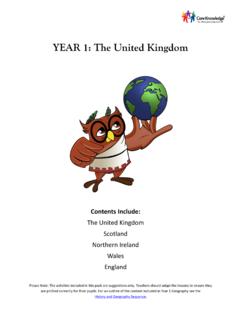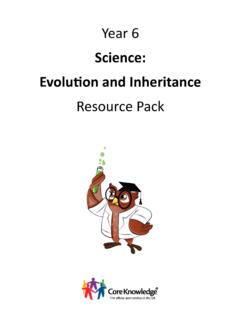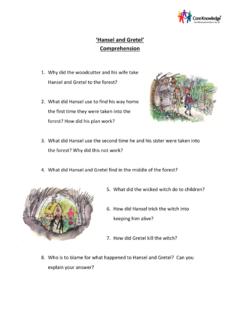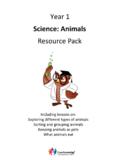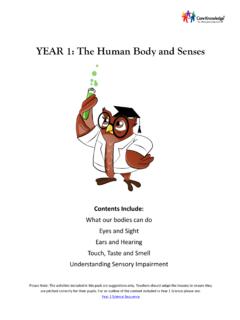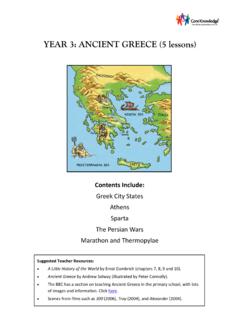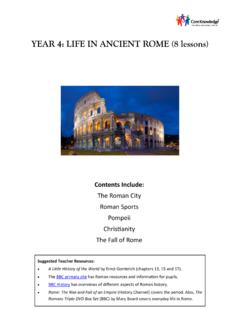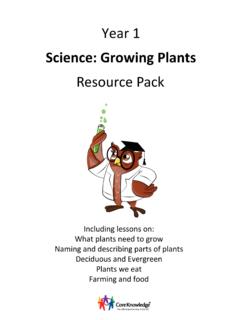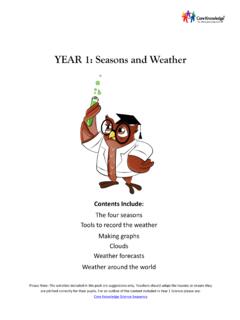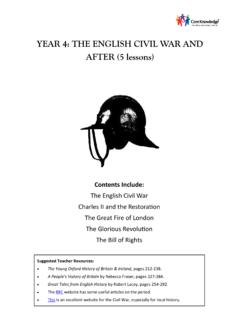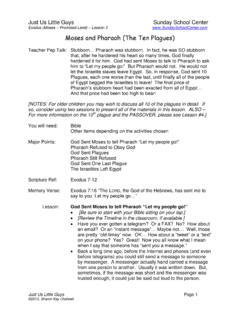Transcription of Year 2 History Ancient Egypt Resource Pack
1 Year 2. History : Ancient Egypt Resource Pack This pack includes the following lessons: Locating Egypt The River Nile Archeology Hieroglyphics Pharaohs Every effort has been made to seek permission for the use of the images within this pack. Please get in touch if you have any questions. This pack is for educational purposes only. Lesson 1. Locating Egypt This lesson is the first in a series that introduces Year 2 children to Ancient Egypt . In this lesson children will learn that maps tell us information about different places. Using their prior knowledge of continents from Year 1, children will identify the continent of Africa before locating the country of Egypt . Even though most of Egypt is desert, the Ancient Egyptians were among the first people to learn how to farm. This is because the Nile River runs through Egypt and floods each year, creating fertile land suitable for farming. In this lesson children should learn that Africa is a continent and Egypt is a country in Africa.
2 They should also be able to identify the River Nile from a map and begin to understand its importance. See Page 158 of What Your Year 2 Child Needs to Know Learning Objective Core Knowledge Activities for Learning Related Assessment Questions Vocabulary -Have world maps, globes and atlases available on the map What information can To identify the location of -Africa is a continent tables in the classroom. Pose question What can we find globe we find from maps? Egypt on a map or a globe. out from maps?' Children explore maps/globes/atlases and atlas - Egypt is a country in write on note paper what they find out. Share and discuss Africa Where is Egypt Africa their findings. Egypt located? continent -The river Nile runs -Show children how Africa is split up into many countries. country What is the difference through Egypt Identify Egypt and show children how to find North East River Nile between a country Africa and highlight the coastline on the Red Sea and the and a continent?
3 Mediterranean Sea. Identify the River Nile and explain its importance. Mention neighbouring countries of Israel, Libya and the Sudan. -Label a blank map of the region using a globe or atlas to help. Resources: The Children's University of Manchester has some fantastic web based resources for teaching this unit. Activity Village has a useful outline of Africa for children to label and locate Egypt . Lesson 2. The River Nile The River Nile is the longest river in the world. It begins in the mountains of central Africa and travels north for thousands of miles before reaching the deserts of Egypt . Once a year the Nile in Egypt overflows, flooding the land beside the river. For about ten miles along either side of the river, the soil turns black. It is rich and full of minerals that help plants to grow. The Ancient Egyptians discovered they could plant seeds in the rich soil and grow plants for food. This meant that they did not need to move around and hunt for food.
4 People settled on the banks of the River Nile and built towns and cities. They began to build a civilisation. See Page 125 and 126 of What Your Year 2 Child Needs to Know Learning Objective Core Knowledge Activities for Learning Related Vocabulary Assessment Questions -Show children the BBC Class Clip- Living near the River Nile Where is Egypt To understand the - The River Nile is in River Nile. Discuss why the river is so important flood located? importance of the River Egypt to people living nearby. silt Nile to the Ancient fertile What is the Egyptians. -The River Nile floods -Children could create a storyboard showing farming difference between a which creates fertile people in the desert, then people discovering the country and a land for farming river and finally setting up their farms and continent? homes. - Ancient Egyptians Why was the River lived near the Nile as -Children could complete independent Nile important for they could grow food writing task- The gift of the Nile.
5 Use fact the Ancient statements to support writing. Egyptians? -Children could write a letter to a family member or friend to tell them about the discovery of the Nile encouraging them to come and live nearby. Resources: This information on the River Nile from the BBC is useful for teacher subject knowledge. Name: Date: LO: To understand the importance of the River Nile to the Ancient Egyptians Before the discovery of the Nile The discovery of the Nile Settling near to the Nile The River Nile Facts The Nile overflows its banks Fertile' means that plants can once a year. grow there easily. The soil at the side of the river The soil is full of minerals that turns black. help the crops to grow. The Ancient Egyptians called The wind blew seeds into the their country Black Land'. soil and plants grew. The Egyptians planted lots of The Egyptians built homes near seeds in the soil. the Nile. Name: Date: The Gift of the Nile Why was the River Nile important to the Ancient Egyptians?
6 Word Bank The Gift of the Nile Word Bank The Gift of the Nile Nile irrigation fertile overflow minerals Black Land Word Bank The Gift of the Nile Nile irrigation fertile overflow minerals Black Land Lesson 3. Archaeologists Archaeology is the study of human History and pre- History , and is undertaken by studying sites and artefacts. In 1922, an archaeologist and Egyptologist named Howard Carter discovered the hidden tomb of King Tutankhamun. The tomb was found in the Valley of the Kings at Thebes, a traditional burial place for Pharaohs. The tomb was untouched and in almost perfect condition. It was full of jewellery, decorated furniture and many artefacts that Ancient Egyptians believed would be needed in the afterlife. King Tutankhamun's gold burial mask can be seen in the Egyptian Museum in Cairo. Archaeologists find out information about how people lived in the past, before written historical records began.
7 See Page 133 of What Your Year 2 Child Needs to Know Learning Objective Core Knowledge Activities for Learning Related Vocabulary Assessment Questions -Tell the story of Howard Carter discovering the archaeology What is archaeology? To understand that - Ancient Egyptians left tomb of Tutankhamen (using Woodland Junior past archaeology helps us pictures, writing and School's comprehensive web based Resource if statues What did Howard to find out about the statues behind. necessary) Discuss the role of an archaeologist. tomb Carter discover? past. - Have images of statues, pictures on stone, archaeologist -Archaeologists are people pyramids, jewellery, and hieroglyphics on tables pyramids Why are the who look for things for children to explore. Encourage children to mummy discoveries that people in the past have read captions and begin to use correct pharaoh archaeologists make, left behind. vocabulary. important to History ?
8 - Children to write notes on images depicting -Tutankhamen was a hunting, fishing, farming, food, homes and pharaoh whose tomb was celebrations. What can we understand from recently discovered by an these pictures? What clues do we have about life archaeologist. in Ancient Egypt ? Resources: BBC Hands on History - Archaeology Food and Farming Clothes and Homes _____ _____. _____ _____. _____ _____. _____ _____. _____ Ancient Egypt _____. _____ _____. By_____. Date: _____. Things people did Hunting _____ _____. _____ _____. _____ _____. _____ _____. _____ _____. _____ _____. Lesson 4. Hieroglyphics Ancient Egyptians used a writing system called Hieroglyphics. The system of hieroglyphics uses over 700 symbols and pictures to represent sounds. The writing can be read from top to bottom or across the page from right to left, or from left to right. The direction the characters (often birds) are facing gives the reader a clue as to which direction they should read.
9 If a bird is facing to the left, the writing must be read from the left. The word Hieroglyph comes from two Greek words; hieros meaning holy and glyphe meaning writing. The word hieroglyph' is a noun and refers to the individual characters whereas the word hieroglyphics' is an adjective which describes the alphabet. We now know many things about how the Ancient Egyptians lived because people have managed to translate hieroglyphics. See Page 130 of What Your Year 2 Child Needs to Know Learning Objective Core Knowledge Activities for Learning Related Vocabulary Assessment Questions - Show some examples of Ancient Egyptian papyrus What does an To understand that - Ancient Egyptians left hieroglyphics. Discuss how the small images they hieroglyphs archaeologist do? hieroglyphics can tell pictures, writing and can see formed part of an alphabet. Explain that hieroglyphics us about life in statues behind. we know things about Ancient Egypt because language What are Ancient Egypt .
10 People have translated the hieroglyphics. translate hieroglyphics? -Hieroglyphics can tell us Rosetta about life in Ancient -Read about the discovery of the Rosetta Stone Greek Why was the Egypt . and explore why it was such a significant Egyptian discovery of the discovery. Rosetta Stone -The Rosetta Stone helped important? people to understand -Explore the hieroglyph cards asking children to hieroglyphics. put some of the symbols together. Emphasise the difficulty of understanding an unfamiliar alphabet without something to help you translate it. Resources: The Children's University of Manchester has some excellent web based resources on Hieroglyphs. BBC Schools explains the importance of the Rosetta Stone. Twinkl have an excellent Resource for Hieroglyphs. Hieroglyphics Draw the hieroglyphs in the box and then write the translation of the word on the line below. Name: Date: The Rosetta Stone Why was the discovery of the Rosetta Stone important?
